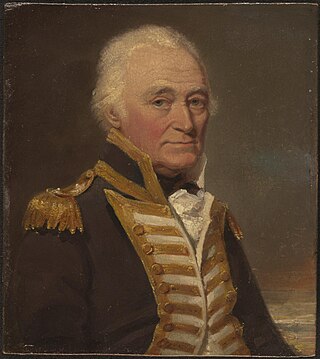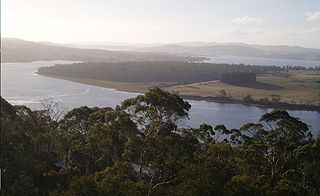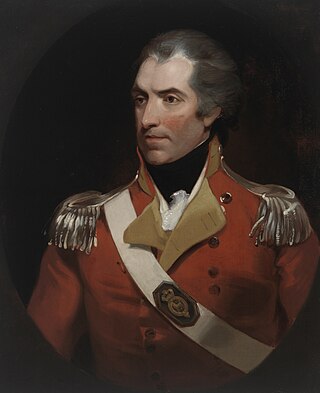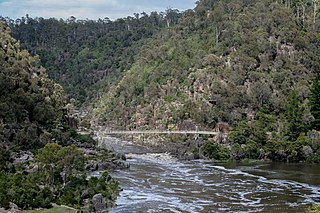Related Research Articles

The First Fleet was a fleet of 11 British ships that took the first British colonists and convicts to Australia. It comprised two Royal Navy vessels, three store ships and six convict transports. On 13 May 1787 the fleet under the command of Captain Arthur Phillip, with over 1400 people, left from Portsmouth, England and took a journey of over 24,000 kilometres (15,000 mi) and over 250 days to eventually arrive in Botany Bay, New South Wales, where a penal colony would become the first British settlement in Australia from 20 January 1788.

Vice Admiral John Hunter was an officer of the Royal Navy, who succeeded Arthur Phillip as the second Governor of New South Wales, serving from 1795 to 1800.

The Tamar River, officially kanamaluka / River Tamar, is a 70-kilometre (43-mile) estuary located in northern Tasmania, Australia. Despite being called a river, the waterway is a brackish and tidal estuary over its entire length.

The current state flag of New South Wales was officially adopted in 1876. The flag is based on the defaced British Blue Ensign with the state badge located in the fly. The badge, based on the coat of arms, is a white disc with the cross of St George, a golden lion passant guardant in the centre of the cross and an eight-pointed gold star on each arm of the cross.

Colonel William Paterson, FRS was a Scottish soldier, explorer, Lieutenant Governor and botanist best known for leading early settlement at Port Dalrymple in Tasmania. In 1795, Paterson gave an order that resulted in the massacre of a number of men, women and children, members of the Bediagal tribe.

The Cataract Gorge is a river gorge in Launceston, Tasmania, Australia, approximately 1.5 km from the city centre. It is one of the region's premier tourist attractions with a Cataract Gorge boat trip leaving from Home Point Parade. It is found at the lower section of the South Esk River.

The South Esk River, the longest river in Tasmania, is a major perennial river located in the northern region of Tasmania, Australia.

The coat of arms of New South Wales is the official coat of arms of the Australian state of New South Wales. It was granted by royal warrant of King Edward VII dated 11 October 1906.
Richard Thomas Baker was an Australian economic botanist, museum curator and educator.

Sir Henry Browne Hayes (1762–1832) was a landowner and Sheriff of Cork City in Ireland. Convicted of the kidnap of a wealthy heiress in Cork, he was subject to penal transportation to New South Wales in 1802 where he built Vaucluse House near Sydney. He was pardoned in 1812 and returned to Ireland. Surviving a shipwreck at the Falkland Islands on the return journey, he retired in Cork where he died in 1832.
HMCS Integrity was a cutter built by the Colonial Government of New South Wales in 1804. She was the first vessel ever launched from a New South Wales dockyard and carried goods between the colony's coastal settlements of Norfolk Island, Newcastle, New South Wales, Van Diemen's Land and Port Jackson. In 1804 she took part in a series of voyages to Van Diemen's Land with the aim of founding a colony at Port Dalrymple, the site of the modern settlement of George Town, Tasmania.

HMS Porpoise was a 12-gun sloop-of-war originally built in Bilbao, Spain, as the packet ship Infanta Amelia. On 6 August 1799 HMS Argo captured her off the coast of Portugal. Porpoise wrecked in 1803 on the North coast of what was then part of the Colony of New South Wales, now called Wreck Reefs, off the coast of Queensland, Australia.

William Applegate Gullick was a publisher and inspector of stamps in New South Wales, Australia. He was an early photographer and designed the Coat of arms of New South Wales.

Arthur Bowes Smyth was a naval surgeon, who traveled on Lady Penrhyn as a part of the First Fleet that established a penal colony in New South Wales. Smyth kept a diary and documented the natural history he encountered in Australia.
Frederick and Maria was launched in 1810 at Chittagong as the country ship Harriett Shakespeare, and quickly renamed. She visited Port Jackson in 1811, and otherwise traded in the Far East. She was reported to have disappeared in a hurricane in 1817. However, the report was in error and she continued to trade with India. Her last voyage appears to have occurred in 1819, though she is listed for some years after that.

The Australian Subscription Library was the first library to exist outside of private collections in Australia. Started in 1826 as the 'Sydney Australian Subscription Library and Reading Room' it shortened its name to the 'Australian Subscription Library' in 1834, and then in 1853 changed its name to the 'Australian Library and Literary Institute’. Its assets were brought by the Government of New South Wales in 1869, and it became the 'Free Public Library'. As the collections and services provided by the 'Free Public Library' expanded it became the State Library of New South Wales, which includes the Mitchell and Dixon library collections.
Andrew Thompson was transported at the age of 18 to New South Wales, arriving in Sydney on 14 February 1792. He rose to become a respected chief constable in the Hawkesbury district, a successful farmer and businessman, and eventually the wealthiest settler in early colonial Australia. In 1810 he was the first ex-convict to be appointed as magistrate.
The Historical Records of New South Wales (HRNSW) is a series of books published by the NSW Government Printer between 1892-1901 compiling information from official sources on the history of NSW and Australia. The HRNSW comprises 7 volumes from the period of Captain Cook 1762-1780 to the Governorship of William Bligh and part way through the Governorship of Lachlan Macquarie 1809-1811. The volumes are also available online.

Captain William George Carlile Kent was an officer in the Royal Navy, who was involved in the early settlement of the Colony of New South Wales, Australia.
John Savage was an English naval surgeon and travel writer on the Antipodes. He was the author of Some account of New Zealand, based on his experiences aboard the Ferrett, which made several voyages to New Zealand.
References
- ↑ Fletcher, B. H. (2005). "Bladen, Frank Murcott (1858–1912)". Australian Dictionary of Biography . Vol. Supplementary Volume. National Centre of Biography, Australian National University. ISSN 1833-7538 . Retrieved 6 April 2017.